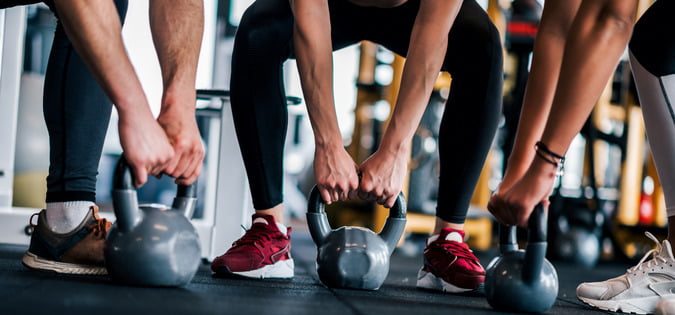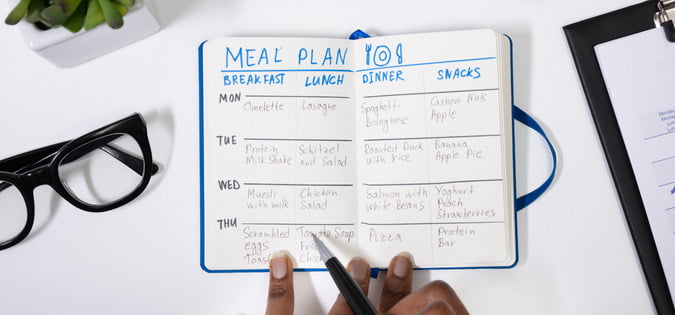It’s a common misconception that if you want to lose weight, tone up and become generally more healthier, the lifestyle change needed is regular exercise rather than addressing poor eating habits.
Regular exercise certainly helps. However, it must be partnered with good choices in food and drinks to be truly effective.
During the time I’ve worked as a fitness professional, I‘ve had many come to me on the basis they’re working out so much harder than they need to. Yet still, they’re not seeing their body change in the ways they want. Often, the issue is eating habits. They’re not geared towards the change they want to see.

It’d be totally awesome if simply adding 2-3 hours of exercise to your routine each week could result in you hitting your health and fitness goals, even with poor food choices being made on a regular basis. Unfortunately, it’s not the case.
Here are five reasons why regular exercise cannot override poor eating habits:
1. You need energy to work out productively
Drumming up the motivation to get to the gym can be a challenge. If you find your gym bag gathering dust under your desk as you tell yourself for the umpteenth time “I’ll definitely go after work tomorrow”, you’re not alone. It takes many of us a level of self-coercion to get to the gym.
Adding in unhealthy foods containing ingredients offering short bursts of energy is yet another obstacle to your gym routine. Who feels like setting out to the gym on an energy crash?

Even if you do manage to get to the gym, are you really going to exercise productively? Or are you going to do a few minutes on the treadmill, call it a day and tick the task off your list? “I still went, didn’t I?” We’ve all done it.
Expecting yourself to somehow perform at your best while simultaneously depriving yourself of energy isn’t going to end well. Be under no illusion – the best workouts are always fuelled by healthy eating. Just as you wouldn’t jump in a car and attempt to drive 100 miles on an empty tank, you shouldn’t assume you can work out effectively without eating enough healthy food to fuel your workouts.
BEFORE EXERCISE
Before you work out, give yourself at least one hour to digest your food. Focus on a meal that’s high in protein and contains an unprocessed carbohydrate source.
The key ingredient to avoid before a workout is fat. Fats take a longer time to break down and can make you feel nauseous when you work out.
By eating lean protein and unprocessed carbohydrates at least an hour before your workout, you’ll have a fantastic session and get the most out of your training time.
2. You need the right foods to enable your body to make the change you want
Just as you need the right fuel to achieve a great workout, you need to eat the right things after you train to achieve the changes you want to make.
Working out in the gym is a catalyst to make changes – it isn’t a means of changing your body on its own. Whether it’s resistance training, intervals on a rowing machine, even body weight movements in a Pilates studio, these are all different challenges or stimuli that your body adapts to.
The foods you eat after you work out will either enable you to adapt more effectively, or hinder your adaptation, thereby decreasing the value of your workouts. By making the right food choices after you work out, you’ll truly see benefit from working out, as opposed to frustration due to a lack of progress.

AFTER EXERCISE
Your post-workout meal needs to include the following:
Protein: protein provides the building blocks to help repair muscle tissue used during exercise. Resistance training of all types (weights, bodyweight, bands etc.) cause small amounts of damage to the targeted muscles you’re working. Protein after you work out is essential to repair that damage, leading to an adaptation where you become a little bit stronger for your next session.
Unprocessed Carbohydrates: when you work out, you use energy stored in your muscle tissue called glycogen. Unprocessed carbohydrates (i.e. brown rice, brown pasta, sweet potato) provide sustained energy by taking longer to break down through digestion. This sustained energy helps your muscle tissue recover and adapt by topping up the glycogen used during exercise. You’ll be able to recover and be ready to exercise again sooner because your energy stores have been replenished.
Mixed, colourful vegetables: mixed, colourful vegetables serve two purposes:
- They provide a wide assortment of vitamins and minerals (the more colours the merrier), and
- They improve your digestion by improving your gut health. Mixed vegetables improve your body’s ability to absorb nutrients through your stomach lining.
This means that by eating mixed vegetables you not only consume a wider assortment of vitamins and minerals, but you also improve your body’s ability to use them.
3. YOU SPEND 4-5 TIMES MORE PREPARING AND EATING FOOD THAN YOU DO WORKING OUT
Time is a limited resource, so we need to maximise how effectively we use it.
In a week we have 168 hours. We spend;
- 49-56 hours approx. sleeping
- 20-30 hours approx. purchasing, preparing, and eating food
- 2-5 hours approx. exercising
- there’s a large gap remaining for working, commuting, socialising etc., but you get the idea

Based on this, the two areas where you can make the biggest impact on your overall health and fitness are sleeping and eating. Whilst sleeping is beyond the scope of this article, this comparison illustrates the relative contribution eating makes to your life on a weekly basis.
So, if you think that eating ‘doesn’t count’ in terms of your overall health, it’s time to think again.
4. REGULAR, VIGOROUS EXERCISE ALONGSIDE POOR EATING HABITS CAN ACTUALLY REVERSE RESULTS YOU WANT TO ACHIEVE
Say for example you’ve chosen to start a fitness programme to help you lose body fat. As an enthusiastic participant, you quite literally ‘hit the ground running’ and follow this vigorous programme to the letter. At the same time, you don’t address your eating habits.
Fast-forward 6 weeks, and nothing has changed. In fact, you’re now farther away from your goal than when you started. How can this be?
Firstly, without having energy from quality nutrients, you won’t perform so well. So your workouts won’t be as effective. Energy is required for exercise. Quality energy = quality workouts.
Secondly, your ability to recover from your exercise will be affected. If you aren’t in the habit of eating well post-exercise, your recovery will be compromised, and you won’t be able to recover as effectively as if you ate well. When you exercise to achieve a goal, your activity will provide a stimulus for a change. This change takes place between workouts and during recovery. For this reason, poor food choices after exercise can seriously hinder your progress.

If you choose to eat less than you need to recover after exercising, your body will detect a lack of resources (based on increased activity and insufficient energy intake). This can lead to a stress response, which in turn results in excess stress hormone (cortisol) release. If this imbalance of activity and energy intake continues, the consistent release of excess cortisol can lead to increased body fat. This is because your body will retain body fat in response to a perceived lack of resources.
This scenario is not specific to fat loss goals. If your mission is to gain lean muscle and you don’t eat appropriately with this goal in mind, your body will resort to using muscle tissue to fuel your workouts. Unchecked, this can lead to a condition known as ‘skinny fat’, in which you lose weight, but you don’t develop lean muscle mass. This leads to a vicious cycle where you keep trying to make progress that’s undercut by your eating habits.
5. EXERCISE ALONE DOES NOT REDUCE THE HEALTH RISKS ASSOCIATED WITH POOR eating habits
When it comes to long-term health risks from poor food choices, the concept of ‘exercising more’ or ‘working out harder’ is an ineffective solution to mitigating those risks.
It’s common practice to forecast health risks based on waist circumference. This is because waist circumference represents an indication of potential risk of type II diabetes, cardiovascular disease and other conditions.
Working out more or with greater intensity, without addressing the underlying food choices leading to these conditions, can make matters worse as opposed to improving them.
According to a recent study published in the British Journal of Sports Medicine, “those who exercised the most and consumed the healthiest food significantly reduced their risk of dying from all causes, from cardiovascular disease, or from certain cancers”1.

This is because excess exercise increases the amount of stress on your body. Excess stress leads to an increase in release of the stress hormone cortisol. Cortisol enables increased release of glucose from our liver to enable accelerated activity i.e. it assisted our ancestors from running away from the bear that was chasing them!
Excess cortisol leads to excess blood sugar, resulting in increased body fat around the waistline. So, by training more in an attempt to mitigate your food choices and their impact on your health, you’re actually increasing the risk you’re trying to prevent.
SUMMARY: How to address poor eating habits
Whether it’s achieving a goal or simply sustaining current progress, your exercise needs to work in tandem with healthy eating habits.
If you try to exercise alone without paying attention to your poor eating habits, you run the risk of frustration and lack of progress. Exercise is an important part of a healthy lifestyle, but it’s healthy eating habits that takes exercise and leverages it for long-term health.
If you believe you’re eating healthily, yet still struggle to see your body change in the way you want, it’s worth considering changing your eating habits. No matter how healthy you believe they are. If they’re not moving you towards the progress you want to make, something needs to change.
The Fit to Last Framework
The Fit to Last Framework is our 12-month nutrition and lifestyle coaching programme based on a series of micro-habits. If you’d like guidance, support and accountability in creating small wins leading to big changes, get in touch.
ABOUT JAMES STARING

 James Staring is a personal trainer based in Clapham, London. His methods have featured in publications such as Your Fitness, Hello, Healthy, Daily Mail, Closer, and many more. After giving up smoking and entering the fitness industry in 2009, James has focused on his passion to help others transform their health and fitness. However, James is convinced most people struggle so much more than they need to in an effort to improve their fitness. Through his company, Fit to Last, James has helped hundreds of men and women make small adjustments in their daily habits to transform their fitness and to love how they look and feel.
James Staring is a personal trainer based in Clapham, London. His methods have featured in publications such as Your Fitness, Hello, Healthy, Daily Mail, Closer, and many more. After giving up smoking and entering the fitness industry in 2009, James has focused on his passion to help others transform their health and fitness. However, James is convinced most people struggle so much more than they need to in an effort to improve their fitness. Through his company, Fit to Last, James has helped hundreds of men and women make small adjustments in their daily habits to transform their fitness and to love how they look and feel.

